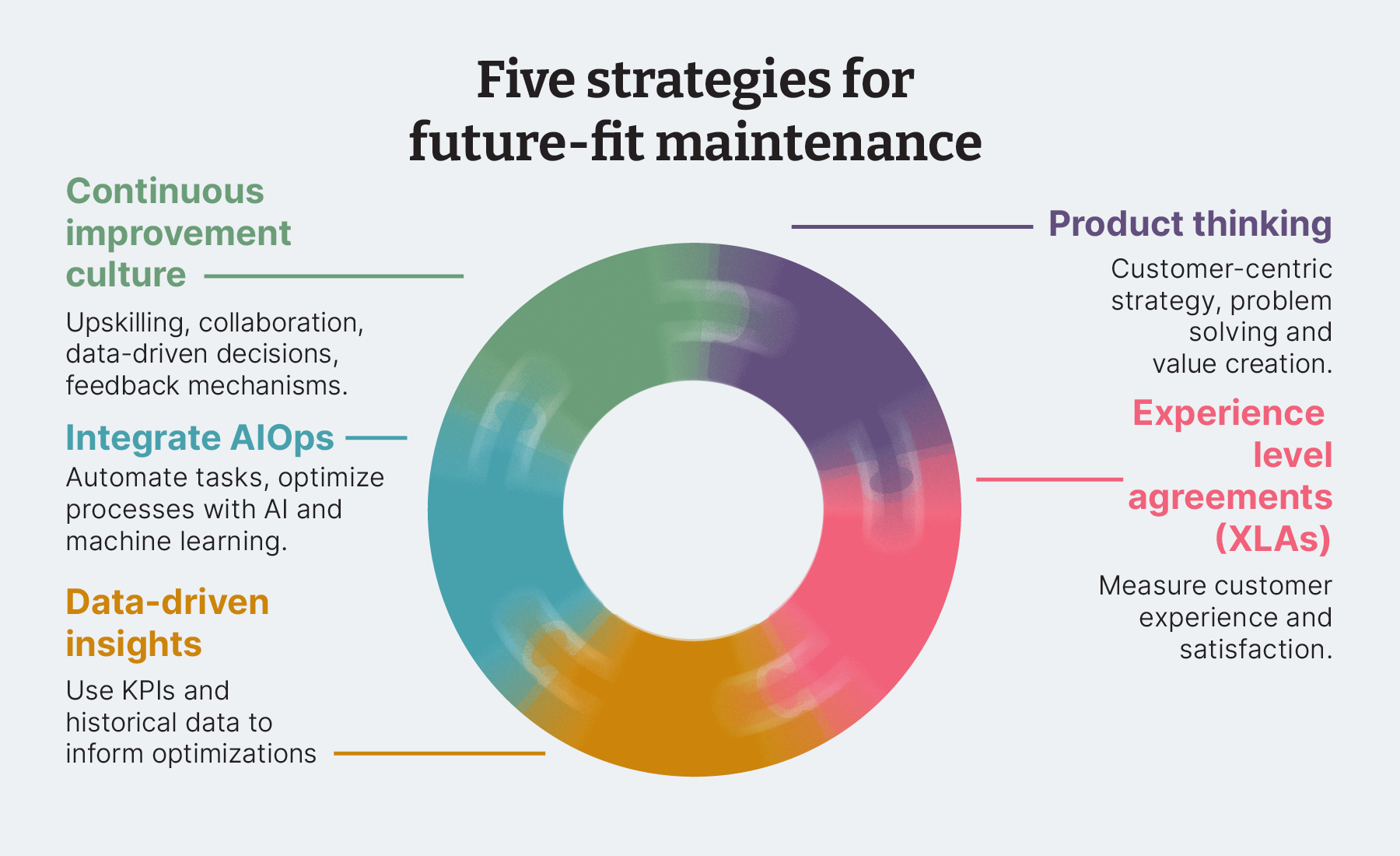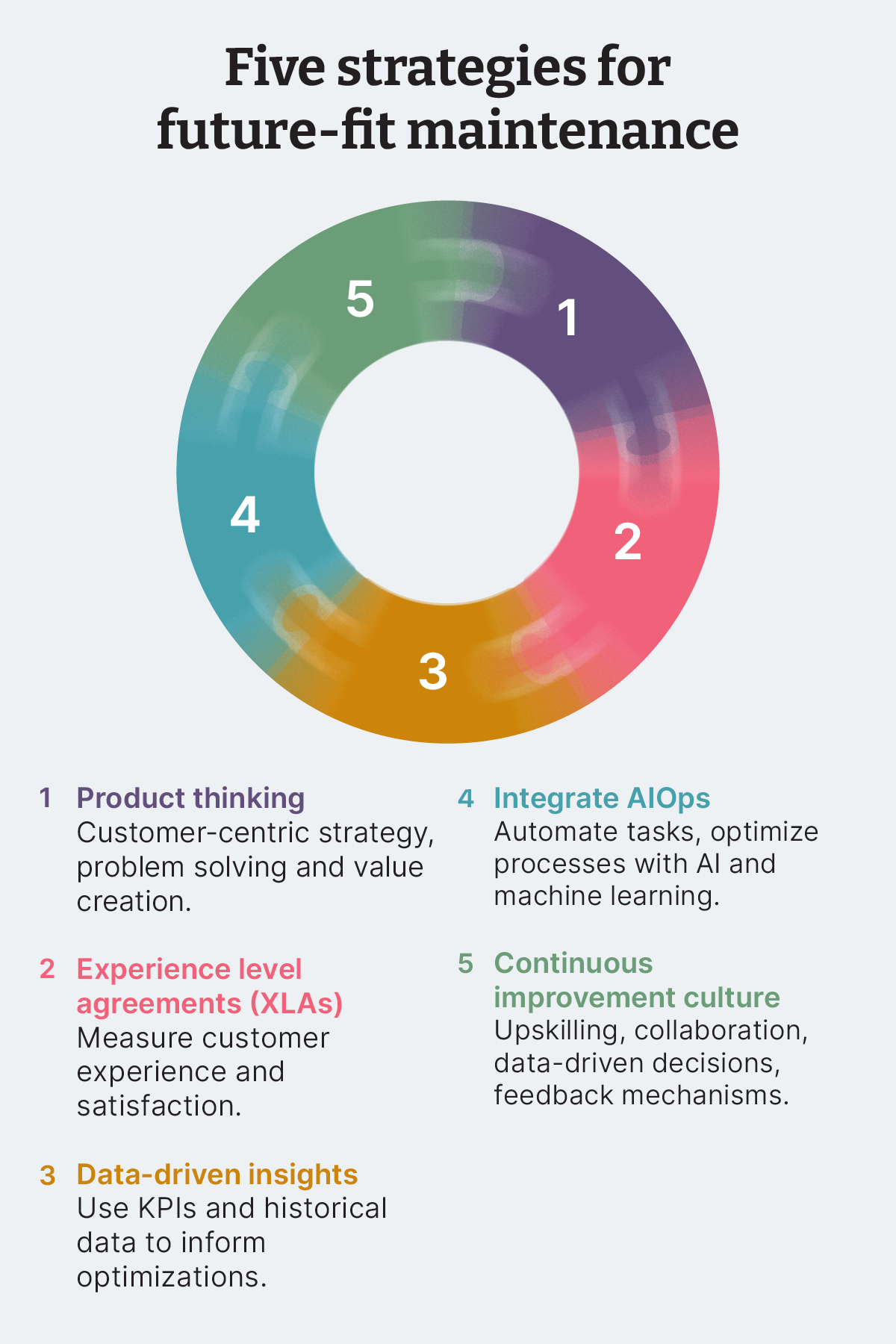Today, organizations need to strike a balance between cost reduction and value creation. That means expectations about what managed service providers deliver needs to change too; they have to do more than just maintain existing assets, they have to help organizations maximize the value of those assets.
Envision your business not only fulfilling customer demands but also anticipating them, constantly improving the applications and infrastructure that serve them, and preventing issues and downtime before they happen. This is the future of managed services.
In this article, we examine five key strategies to set your organization up for future-fit maintenance — increasing efficiency, reducing cost and maximizing the value from your existing digital assets.


Adopt a product thinking mindset: The typical maintenance mindset focuses on stability and reliability, troubleshooting, resource efficiency to sustain the current state and short-term goals to maintain existing functionality rather than introducing new features or innovations. We propose a mindset shift to product thinking, one that prioritizes the long-term growth and future development of your tech estate. Product thinking is driven by a deep understanding of user needs, a commitment to solving problems and a relentless pursuit of value creation and innovation.
Customer needs are constantly evolving, as is the market your business competes in. The pressure to innovate and the need to quickly adapt to changes in customer demand, regulatory requirements and the competitive landscape has never been more important. By putting the customer at the center of your strategy, you can tailor your digital assets to deliver maximum value and enhance customer satisfaction.
Incorporate experience level agreements (XLAs): XLAs extend beyond traditional service level agreement (SLA) metrics to address overall customer experience and satisfaction. They aim to measure not just what was done but how it impacted customers, including service responsiveness, user satisfaction and overall service usability. A variety of metrics can be employed to assess performance against XLAs, such as net promoter score (NPS), customer satisfaction (CSAT), revenue per user (RPU) and average order value (AOV). XLAs encourage a culture of continuous improvement by helping you proactively identify areas for improvement and enhance customer satisfaction.
XLAs should be embedded in the service management process and become as integral to operations as SLAs. This involves collaboration at the leadership level to set experience objectives that are aligned to specific business goals and customer expectations.
Use data-driven insights: Lean on data analytics and performance metrics to predict and identify trends, patterns and areas of inefficiency or risk in maintenance operations. Key performance indicators (KPIs) related to maintenance activities — downtime, mean time to repair (MTTR), and first-time fix rate — should be constantly monitored to track performance and drive continuous improvement. Historical data from tickets should also be analyzed to identify recurring problems, root causes, and opportunities for preventative maintenance to optimize. These insights should inform the product backlog.
Integrate AIOps: Artificial intelligence (AI) and machine learning (ML) algorithms can be used to automate and optimize the routine tasks and processes involved in managing IT applications and infrastructure. By implementing AIOps, you can reduce the skills gap with AI-assisted support and operate significantly more efficiently and effectively, improving the quality of software updates and increasing your ability to recognize patterns and respond to issues. It can and ultimately decrease your year-over-year run costs.
The real-time insights you gain from AI fuel a continuous cycle of knowledge, discovery, and enhancement that allows you to make ongoing iterative improvements to your applications over time.
Manifest a culture of continuous improvement [within managed services]: Every member of the team should be committed to identifying opportunities for enhancement, implementing changes and regularly evaluating and refining maintenance processes, practices and systems. Here’s how to foster this:
- Encourage employees to acquire new skills, develop existing skills and stay updated on best practices and emerging technology.
- Create an environment that allows open communication and cross-functional collaboration.
- Empower employees to take ownership of their work and participate in the decision-making processes.
- Use data-driven insights to drive, prioritize and measure ongoing optimizations and improvements.
- Establish mechanisms for gathering continuous feedback so it can be evaluated and actioned in a timely manner.
- Cultivate a problem-solving culture where challenges and setbacks are viewed as opportunities for learning and improvement, rather than obstacles to be avoided.
- Celebrate success and recognize achievements and milestones in your continuous improvement journey to drive positive change.
Find the right partner for change
Shifting to a future-fit maintenance approach can significantly impact your organization’s efficiency and bottom line, and finding the right partner to help will ease what may seem like a daunting transition. The right managed services partner will bring specialized expertise and experience in implementing proactive maintenance strategies, like continuous discovery, and integrating advanced technologies like AIOps into existing systems. When working with a trusted partner, enterprises can mitigate risks associated with the transition process and accelerate the realization of cost savings and operational improvements, ultimately driving greater competitiveness and long-term success. Having a dedicated team of professionals who can focus on optimizing maintenance operations also frees up your internal team to concentrate on core business initiatives.
Thoughtworks' AI-Powered DAMO™ Managed Services applies leading engineering practices that revolutionized software development to maintenance. We focus on evolution, providing organizations with strategic insight from AI and engineering expertise to enhance and transform their applications so that they remain responsive and resilient in the face of changing customer, business, and market requirements.



















